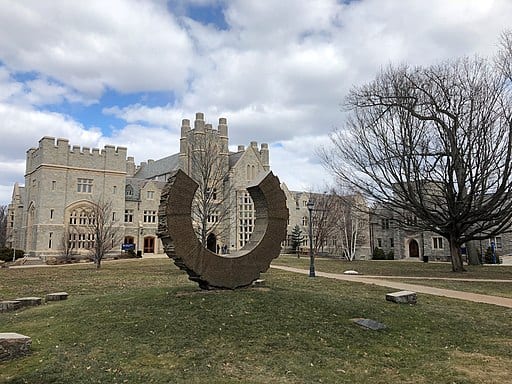University education in the U.S. doesn’t come cheap. Over the past few decades, the cost of attending a university in the country has surged at an alarming rate, surpassing the growth of inflation and wages.
The soaring cost of tuition, housing, and other associated expenses has created a significant financial burden for many students and families, often leading to high levels of student debt. According to recent data, approximately 43.8 million Americans collectively owe over $1.7 trillion in student loan debt.
Attending a public university is often seen as a more affordable option, but a public university in the U.S. can be as costly as a private one. This article lists 8 of the most expensive public universities in the U.S. for undergraduate studies.
While making this list, we only considered the tuition fees and not the other associated costs, including books, accommodation, transportation, etc. Also, note that the tuition fees differ largely depending on the program of study, credit hours, and many other factors. In this article, we have mentioned the base average tuition fees and ranked them accordingly.
8. Colorado School of Mines
Annual tuition fees (in-state residents): $20,200
Location: Golden, Colorado
Established: 1874

Colorado School of Mines is one of the country’s oldest and most prestigious engineering schools. This public research university offers undergraduate and graduate programs in engineering and science disciplines, including mining engineering, petroleum engineering, geology, applied mathematics and statistics, physics, and environmental science.
The university offers minor degrees in humanities, social science, and arts subjects but only offers majors in STEM and economics. The curriculum at Mines is heavily focused on hands-on learning and experiential education, emphasizing interdisciplinary research and collaboration.
Did you know?
The Colorado School of Mines has a unique tradition where first-year students participate in a climb, commonly known as the “M climb,” during their orientation weekend. As part of this tradition, students hike the nearby Mount Zion while carrying a ten-pound rock from their hometown.
7. University of Connecticut
Annual tuition fees (in-state residents): $20,366
Location: Storrs, Connecticut
Established: 1881

The University of Connecticut, commonly known as UConn, is a top-notch public research institute considered a Public Ivy.
The university offers over 100 undergraduate majors and 17 graduate programs, and five professional degree programs across its 14 schools and colleges. Some well-known schools and colleges under UConn are the College of Liberal Arts and Sciences, School of Medicine, Neag School of Education, School of Law, Ratcliffe Hicks School of Agriculture, School of Social Works, and others.
UConn has a diverse student body, with over 32,000 undergraduate and graduate students from all 50 states and over 100 countries.
UConn is also home to several research centers and institutes that provide opportunities for students and faculty to engage in cutting-edge research in genomics, nanotechnology, renewable energy, and human health.
Did you know?
The official mascot of UConn is a husky dog, and all UConn huskies are named Jonathan. The current husky is Jonathan XIV, who can be spotted at many of the university’s athletic events and other special occasions.
6. University of Vermont
Annual tuition fees (in-state residents): $18,810
Location: Burlington, Vermont
Established: 1791

The University of Vermont (UVM) is one of the oldest universities in the U.S. It was established in 1791 as a private university, the same year as Vermont became a state. In 1865, it merged with Vermont Agricultural College and was granted 150,000 acres of land.
UVM offers over 100 undergraduate minors across its seven undergraduate colleges, including the College of Arts and Sciences, the College of Agriculture and Life Sciences, the Grossman School of Business, and the College of Education and Social Services.
Besides, it has an honors college, a graduate college, and a medical college. However, the students at the Honors College need to enroll in one of the undergraduate colleges to get a degree, as the Honors College doesn’t offer one.
Did you know?
UVM stands for Universitas Viridis Montis, a Latin phrase meaning the University of Green Mountains.
5. University of California, Merced
Annual tuition fees (in-state residents): $14,840
Location: Merced, California
Established: 2005

The University of California, Merced is the newest of the 10 University of California system campuses.
The university is in the San Joaquin Valley, known for its rich agricultural heritage. The campus is spread over 910 acres of land and surrounded by natural beauty, including Lake Yosemite and the Sierra Nevada Mountains.
The campus design is inspired by the natural environment, with sustainable features such as solar panels and water conservation systems incorporated into the architecture.
The university has three academic schools: the School of Engineering, the School of Natural Sciences, and the School of Social Sciences, Humanities, and Arts. In addition, UC Merced has several research centers and institutes, including the Sierra Nevada Research Institute and the UC Merced Energy Research Institute. The university offers over 20 undergraduate majors and 30 graduate programs, including a Ph.D. program in Environmental Systems.
Did you know?
UC Merced is the first U.S. research university built in the 21st century.
4. University of California, Santa Cruz
Annual tuition fees (in-state residents): $15,288
Location: Santa Cruz
Established: 1965

The University of California, Santa Cruz (UCSC) is located on 2,001 acres of rolling hills and redwood forests overlooking the Pacific Ocean. The university was established in 1965 to promote progressive interdisciplinary undergraduate education and innovative pedagogy.
UCSC is organized into ten residential colleges with distinctive identities and academic programs. The university offers 65 undergraduate majors, 41 minors, and 65 graduate programs in chemistry, molecular and cell biology, physics, psychology, and environmental studies.
UCSC has several highly accomplished faculty members, including Nobel laureate Carolyn Widney Greider, who won the Nobel Prize in Physiology or Medicine for her groundbreaking research on telomeres and telomerase.
Did you know?
In December 1959, the Regents of the University of California voted to build a new campus in Santa Clara Valley, San Jose. However, as soon as the announcement was made, the property value in the area increased so much that Regents couldn’t afford to buy the required land for the campus.
3. University of California, San Diego
Annual tuition fees (in-state residents): $18,147
Location: La Jolla, San Diego
Established: 1960

The University of California, San Diego (UCSD) is the most expensive in the U.C. system. It is located in the picturesque coastal community of La Jolla, surrounded by breathtaking views of the Pacific Ocean and the Torrey Pines State Natural Reserve.
UCSD is organized into twelve undergraduate, graduate, and professional schools and seven undergraduate residential colleges. It offers 35 master’s programs, 47 doctoral programs, and five professional programs. Additionally, the university offers nine joint doctoral programs in collaboration with San Diego State University and other U.C. campuses.
UCSD is a leading research institution with over $1 billion in annual funding and numerous groundbreaking discoveries by its faculty and researchers. The university is renowned for its biotechnology, oceanography, neuroscience, and climate science research.
Notable research centers at UCSD include the Scripps Institution of Oceanography, the Qualcomm Institute for Telecommunications and Information Technology, and the Center for Energy Research.
Did you know?
The site selection process for UCSD was initially jeopardized by the controversy surrounding the La Jolla community’s exclusive real estate practices, discriminatory towards minority racial and religious groups. However, the controversy was contained by changing the name from the University of California, La Jolla to University of California, San Diego.
2. University of Michigan
Annual tuition fees (in-state residents): $16,736+
Location: Ann Arbor
Established: 1817

The University of Michigan (U.M.) is the oldest university in Michigan. The university is renowned for its outstanding academic programs, world-class research, and a strong commitment to diversity, equity, and inclusion.
U.M. offers over 275 programs across 19 schools and colleges, including undergraduate, graduate, and professional degrees. Its most highly regarded programs include business, law, engineering, medicine, and public policy. U.M. is also known for its vibrant student life, with over 1,500 student organizations and a thriving arts and culture scene.
The university has a long history of research breakthroughs, including the development of the first successful polio vaccine, the discovery of the electron, and the creation of the first artificial heart valve. U.M. is also home to several world-class research centers and institutes, including the Michigan Medicine health system, the Ross School of Business Zell Lurie Institute for Entrepreneurial Studies, and the Institute for Social Research.
Did you know?
The University of Michigan was established as the Catholepistemiad, a centralized system of schools, libraries, and cultural institutions modeled after the Imperial University of France.
1. University of Virginia
Annual tuition fees (in-state residents): $18,938
Location: Charlottesville, Virginia
Established: 1819

The University of Virginia (UVA) is the most expensive private university in the United States for out-of-state students. However, annual tuition and fees for in-state residents are higher in some other universities, including UConn and Mines. It is a flagship university of Virginia; still, the state funding has reduced rapidly over the past few decades. It is one of the key reasons why the tuition fees are so high in this Public Ivy.
UVA offers over 100 undergraduate and graduate degree programs across eight undergraduate and three professional schools. The professional schools include the School of Law, the Darden School of Business, and the School of Medicine.
The university is particularly well known for its undergraduate programs in political science, economics, and history and graduate programs in business and law.
Did you know?
The Lawn in UVA is a prestigious place where 54 final-year undergraduates are invited to live each year. These students get to learn from ten faculty members who permanently live and teach there.
